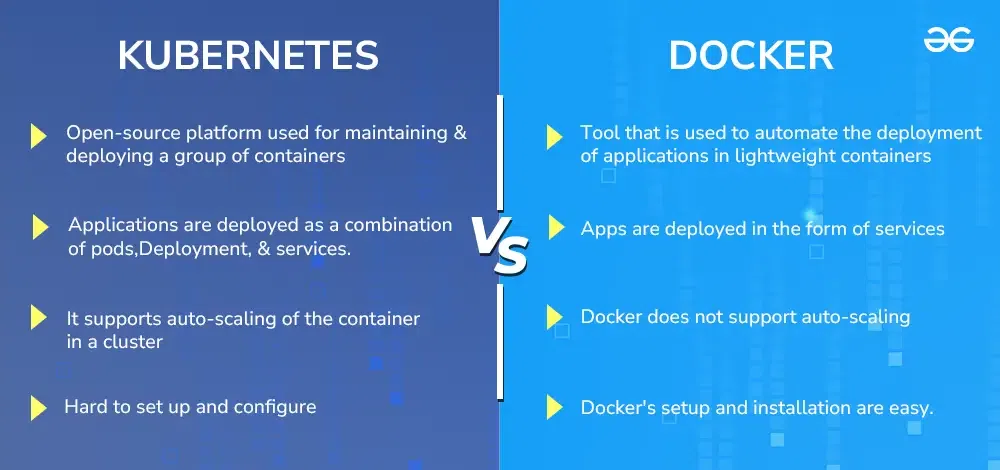Managing containerized applications is crucial in modern development workflows, and two prominent technologies—Kubernetes vs. Docker—stand out as essential tools. Understanding their differences and when to use each can clarify your software development strategies.
Understanding Docker: The Building Block of Containers
Docker revolutionized software development by introducing containerization, enabling developers to package applications with their dependencies into lightweight, portable units.
Key Features of Docker
- Ease of Use: Simplifies container creation, sharing, and execution.
- Isolation: Each container operates independently, avoiding conflicts between applications.
- Portability: Runs consistently across environments, from a developer’s machine to production servers.
- Version Control: Manages different application versions seamlessly.
Docker’s main goal is to streamline application deployment by creating reusable, consistent environments.
What is Kubernetes? Mastering Orchestration
Kubernetes, often called “K8s,” is an open-source platform designed to manage and scale containerized applications. While Docker builds containers, Kubernetes focuses on their orchestration.
Key Features of Kubernetes
- Automated Scaling: Adjusts resources dynamically based on application needs.
- Self-Healing: Recreates failed containers to ensure uptime.
- Service Discovery: Integrates routing and balancing traffic to multiple containers.
- Storage Orchestration: Offers flexible storage options for persistent data management.
Kubernetes simplifies managing large containerized ecosystems, promoting reliability and scalability.
Kubernetes vs Docker: Core Differences
The Kubernetes vs. Docker debate often centers on their functionalities and purposes. Though related, they address different aspects of containerized workflows.
| Feature | Kubernetes | Docker |
|---|---|---|
| Purpose | Orchestrates and manages containers. | Builds, runs, and manages containers. |
| Complexity | It requires significant setup and expertise. | Easy to use, even for beginners. |
| Scalability | Handles large, distributed systems well. | Works best for small deployments. |
| Fault Tolerance | Automatically replaces failing containers. | Limited built-in redundancy. |
How Kubernetes and Docker Work Together
Although Kubernetes and Docker differ fundamentally, they complement each other beautifully in advanced workflows. Docker creates containers, while Kubernetes orchestrates them. Together, they enable streamlined deployments at scale.
For instance, Docker can package a microservice-based application, while Kubernetes ensures smooth scaling, updating, and load balancing across servers.
Use Cases for Kubernetes vs Docker
Understanding where to use Kubernetes and Docker helps optimize workflows.
When to Use Docker
- Rapid development and prototyping of containerized applications.
- Small-scale deployments requiring minimal orchestration.
- Portable development environments.
When to Use Kubernetes
- Managing large-scale, distributed systems with numerous containers.
- Ensuring high availability with self-healing mechanisms.
- Complex applications requiring advanced orchestration capabilities.
Both are suitable for cloud-native environments and agile development practices.
Key Advantages of Kubernetes and Docker
Let’s break down their unique advantages:
Benefits of Docker
- Faster application deployments.
- Lightweight and efficient performance.
- Ecosystem compatibility, supporting Kubernetes and other tools.
Benefits of Kubernetes
- Enterprise-grade scalability and flexibility.
- Seamless updates without downtime.
- Robust failover capabilities for critical applications.
Combining both technologies leverages their strengths to achieve a seamless pipeline.
Challenges of Kubernetes and Docker
While powerful, Kubernetes vs. Docker adoption has its challenges:
Common Docker Challenges
- Security concerns in large deployments.
- Limited orchestration capabilities without Kubernetes.
Common Kubernetes Challenges
- Complex configuration and steep learning curve.
- Resource-intensive management of large clusters.
Proactively addressing these challenges ensures smoother implementation.
Also read: What Is Clean Architecture? A Simple Guide
Step-by-Step Guide: Setting Up Kubernetes with Docker
Both Kubernetes and Docker can integrate efficiently. Here’s how:
- Install Docker: Set up Docker on your system for container creation.
- Install Kubernetes: Use tools like Minikube for Kubernetes deployment.
- Create Containers: Build your application using Docker.
- Define Configuration: Write Kubernetes YAML files to specify container behavior.
- Deploy Application: Use Kubernetes to manage and run your Docker containers.
- Monitor and Scale: Use Kubernetes’ monitoring tools to optimize performance.
Conclusion
Choosing between Kubernetes and Docker depends on your project’s scale and complexity. While Docker excels at container creation and lightweight deployments, Kubernetes manages extensive, distributed ecosystems effectively. Together, they form the backbone of modern containerized solutions, empowering developers and enterprises alike.
To fully harness their potential, aligning your workflows with their strengths and purposes ensures efficient, scalable, and resilient software deployments.
FAQs
What is the primary difference between Kubernetes and Docker?
Docker specializes in creating containers, while Kubernetes focuses on orchestrating and managing them.
Can Kubernetes and Docker be used together?
Yes, Kubernetes uses Docker for container runtime, combining orchestration with container management.
Is Kubernetes difficult to learn?
Kubernetes requires some learning due to its complexity, but tutorials and tools simplify the process.
Why is Docker more popular among beginners?
Docker’s simplicity and accessibility make it ideal for developers starting with containers.
Which tool is better for small projects?
Docker is generally better for small projects due to its lightweight nature and ease of setup.
Is Kubernetes only for enterprises?
No, Kubernetes benefits any environment needing robust container orchestration, regardless of size.



